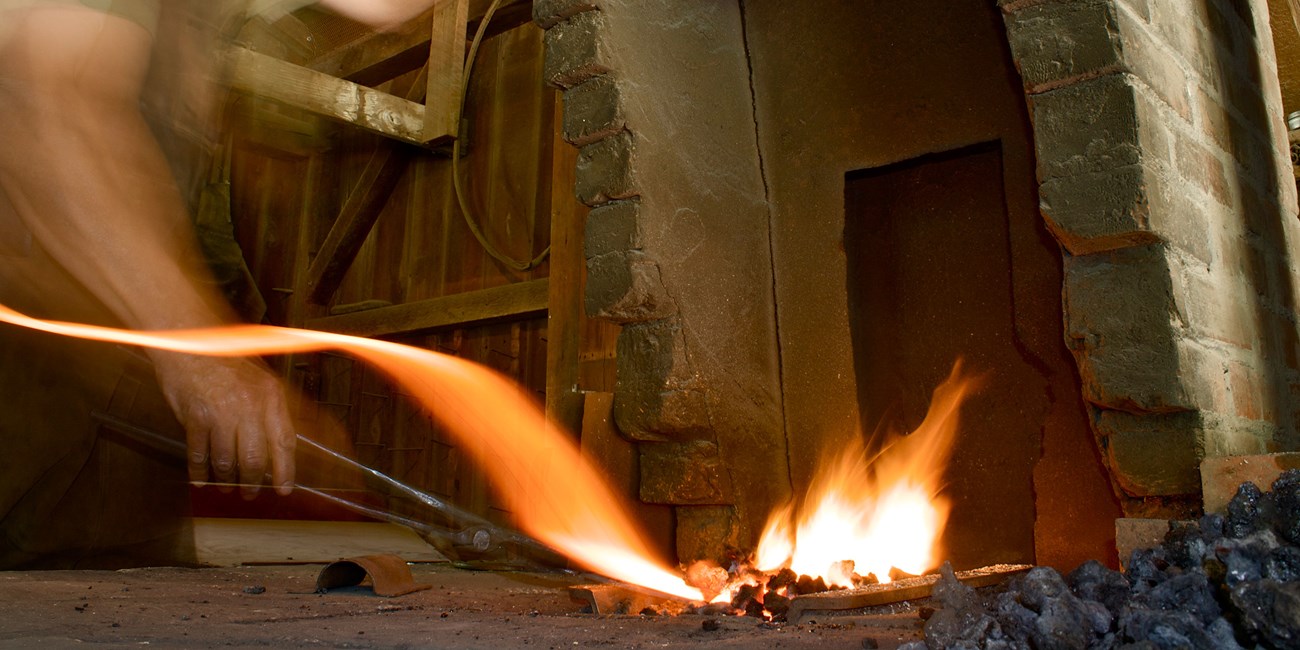Last updated: January 23, 2021
Article
Blacksmithing At Herbert Hoover National Historic Site

NPS Photo by John Eicher
The Blacksmith Shop at Herbert Hoover National Historic Site is a working smithy. The blacksmiths are trained in the same style as President Hoover's father, Jesse Hoover. It is a style known as traditional blacksmithing, where the techniques, tools, and fuel sources are what have been used for centuries. The blacksmiths demonstrate the skill and hard work needed to turn ordinary iron into useful things.
Physical & Mental Skill
Blacksmithing takes a lot of effort— pure physical strength, but more often mental strength. Blacksmiths spend years mastering their art, traditionally serving as an apprentice before going into business on their own. A blacksmith must always be a good problem solver, sometimes using mathematics, chemistry, and even physics to produce a quality product.
Jesse Hoover possessed the necessary business skills to operate his own blacksmith and wagon repair shop. He sold his growing business in 1878 to open a new farm implement store on the corner of Main and First Streets.
Heating The Metal
This shop, like Jesse Hoover’s, runs on coal for fuel. Coal is stored in a bucket by the forge and in a large bin in the northwest corner of the shop.
Blacksmiths cook the coal until most of the impurities are burned off. The result is coke, a fuel that is almost entirely carbon allowing us to reach temperature of 3,000 to 4,000 degrees Fahrenheit at the core of the fire! Fire this hot can quickly get the metal up to welding temperatures at about 2,500 degrees.
| Temperatures | Color | Description |
|---|---|---|
| 400 to 500 °F | Dull Grey | Too cold to work |
| 900 °F | Red | |
| 1,300 to 1,950 °F | Orange | |
| 2,000 °F | Yellow | Typical forging temperature |
| 2,100 to 2,500 °F | Bright Yellow to White | Hot enough to weld |
Shaping the Metal
Once the preferred shape has been created, the smith puts the still-hot iron into a quenching tank of cool water to solidify the steel and cool it to a safe touching temperature once again. When forging is complete the dinner triangle, tool, or other object is ready to be put into use. Have a look on the walls of the shop and you can see many of the objects our blacksmiths have created.
With a creative, problem solving mind and the right tools, a blacksmith can create almost any shape from metal. Many skilled blacksmiths today primarily work as artisans and show their creativity through shaping metal. Jesse Hoover used his own skills to provide a service to the community.
When Jesse Hoover was at work a working blacksmith shop was common. A blacksmith’s work played a crucial role in everyday life of almost every citizen in a 1870s Iowa town. Today the trade lives on here at Herbert Hoover National Historic Site.
Tools Of A Blacksmith
Are there any tools in this blacksmith shop that look similar to something in your own home?
The main tool is the forge, the brick furnace and chimney where the blacksmith burns coal. The iconic tools of a blacksmith, the hammer and anvil, are just to the left of the forge. Every blacksmith shop will have differently sized and shaped hammers and at least one anvil.
The tongs around the forge are to hold hot iron while working it into shape. Each pair of tongs has a specific purpose and is used depending on the shape of the metal or the angle the blacksmith is working on.
The bellows is another important tool. This smithy has a two-stage bellows just behind the forge. A simple pull on the handle hanging above it raises the top section of the bellows. The collapsing weight of the bellows forces air through a pipe directly into the forge and in to the fire. This adds more oxygen, allowing the fire to reach hotter temperatures.
